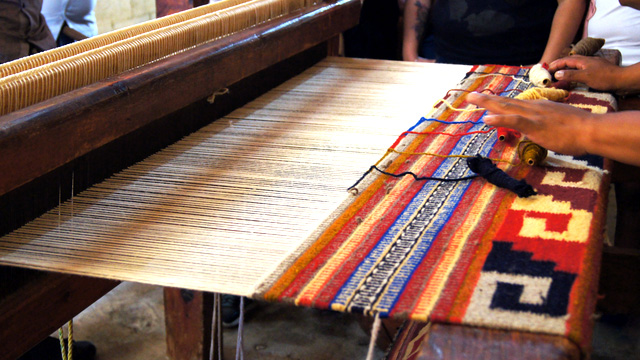
TEXTILES
of the Mercado Area

It's sometimes said that the sophistication of ancient American indigenous cultures has been underestimated because much of their art was of the perishable kind. This must certainly be the case with woven textiles. Today Mexicans continue to weave traditional cloth masterpieces, a case in point being described in our meeting with Sr. Fidel Nava Medina, the serape maker in Gualupita Yanhuitlalpan, Mexico State, in our "Producers of Goods" section. When you buy textiles at Mexican mercados it's always interesting to ask where the textiles were actually made. Those in the photo above are Guatemalan textiles sold in a Mexican town famous as a tourist destination.

Though Sr. Nava was working with wool, and wool was introduced by the Spaniards, cotton was known to the ancients. The Aztec warriors who opposed the conquistadors as they invaded central Mexico wore armor incorporating cotton padding. Of course, this padding may have been effective against the primitive weapons of other Indian nations, but it yielded all too often to the blows of metal sabers and cannonshot inflicted by the Spanish. Today very pretty embroidered cotton blouses such as those above are available.

Ancient Native Americans also had looms before the Spanish introduced European-style ones. They utilzed backstrap looms such at the one drawn above. Sometimes these can still be seen used in upland Chiapas. Notice that the longitudinal threads are kept taut by tying one end of the loom around a tree, and wrapping the other end around the back as one leans backwards.
 Though nowadays
it's possible to find anything and everything woven to generic-tourist taste, many
traditional textile products continue to be available in Mexico. Among the most-bought
among tourists are roomy, prettily embroidered smock-like dresses such as the ones
appearing to the right, and the embroidered blouses at the top of this page. Another basic
item, a large rectangular piece with various designs woven into it, is the serape. Though
only a few Mexicans still sling serapes over their shoulders, serapes are big tourist
fare. They make excellent wall hangings and tablecloths.
Though nowadays
it's possible to find anything and everything woven to generic-tourist taste, many
traditional textile products continue to be available in Mexico. Among the most-bought
among tourists are roomy, prettily embroidered smock-like dresses such as the ones
appearing to the right, and the embroidered blouses at the top of this page. Another basic
item, a large rectangular piece with various designs woven into it, is the serape. Though
only a few Mexicans still sling serapes over their shoulders, serapes are big tourist
fare. They make excellent wall hangings and tablecloths.
In the Yucatán Peninsula, hammocks as the most popular woven items; they can be purchased in cotton, nylon, silk, and rough and scratchy henequen-fiber models. Three-ply ones are less likely to stretch and develop snapped strings than double- and single-threaded ones. Average-size Mexicans are much smaller than average-size gringos, so sencillo hammocks designed for one person are typically too small for most tourists; the doble meant for two is usually just right. If you really like the idea of two-in-a-hammock, then buy familiares or matrimoniales especiales.